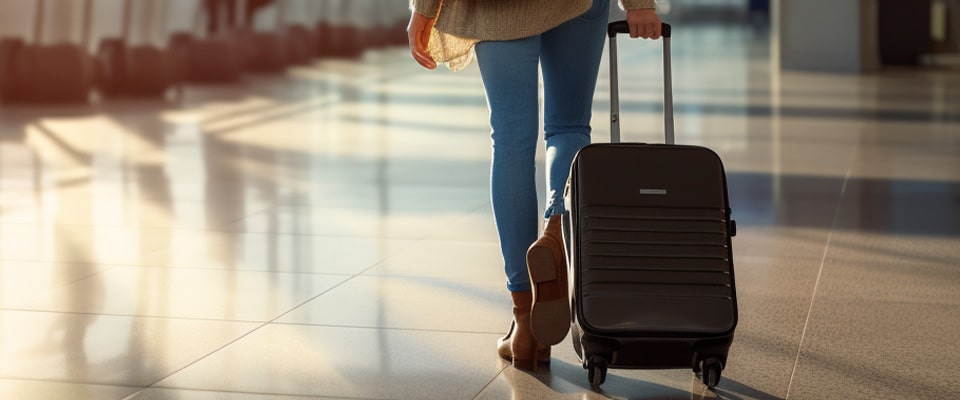The Role of Lithium Batteries in Air Travel: From Enhancing Productivity to Safety
Last updated Tuesday, October 22nd, 2024

Importance of Lithium Batteries in Air Travel
Lithium-ion batteries have helped us take our work and entertainment wherever we go. We’re talking about the great portability they brought to all devices. Gone are the days of cartoonishly huge and heavy devices that would run out of battery within a couple of hours. Lithium Batteries in Air Travel are necessary these days.
Your laptop, smartphone, camera, electric shaver, and every other gadget is now thin and lightweight. You can easily carry them all in your luggage when you fly.
What’s the secret? High energy density. Lithium-ion batteries can pack a lot of energy in a tiny frame. They provide a steady flow of power even during heavy usage and long-lasting energy storage. These killer features have helped make our devices an essential part of life. But now that our lives are tied to them 24/7, it’s hard to imagine traveling without them.
You have to think about more than personal convenience when it comes to air travel. It’s a matter of safety.
A lithium-ion battery fire or explosion can turn your flight into a death trap within minutes. That’s why air travel authorities have established some strict guidelines about traveling with lithium-ion batteries. In this article, we’ll take you through the do’s and don’ts of traveling with Li-ion batteries. We’ll also share tips to safely and efficiently pack them without facing any hassle at the airport.
The Benefits of Carrying Lithium Batteries on Planes

You can stay connected with your team and keep in touch with your loved ones for most of your journey. Even the lack of phone and internet connectivity won’t stop you if you plan your workflow right. You can simply download all the information you’ll need earlier and continue your work offline.
No in-flight entertainment during the flight? No problem. Download your favorite movies and shows on your preferred device ahead of time. Boredom won’t touch you and productivity won’t let you down.
You can even purchase stand-alone lithium-ion battery packs as emergency backup power sources. Your travel plans may have you hopping from place to place with no time to charge your devices on the go. You may need to make an urgent online payment or navigate your way back to your hotel. So when your phone suddenly runs out of battery juice, it’s not going to be easy.
But don’t worry! Your device’s lithium-ion battery may have let you down, but another lithium-ion battery will save the day. We’re talking about a power bank, which has become one of the most popular travel gadgets for people. It’s nothing but a portable Li-ion battery-powered charging station.
It can juice up your electric devices quickly wherever you go. These power banks usually offer 600-1000 charge cycles and can last from 1.5 to 3 years. They’ll help you enjoy uninterrupted use of essential electronic devices during unforeseen circumstances.
The Risks Associated with Lithium Batteries on Planes
Most of us have grown up watching a light bulb or a small appliance short circuit. It makes a little noise and the device quietly stops working.
So why the fuss about your devices malfunctioning while you travel? Because a short-circuiting Li-ion battery probably won’t be so gentle with your device. It’ll go out with a bang and cause a lot more damage to anything present around it.
A short-circuiting Li-ion cell produces 15-20 times more current than its standard capacity, which produces a sudden rise in pressure and temperature. It sets fire to the flammable cell components and starts a chain reaction that can blow up multiple cells packed with it. All this energy is released with a great explosive force. The battery fire is intense and spreads aggressively within seconds.
There are many real-life horror stories like a Li-ion battery fire burning down a massive Bronx supermarket within 10 minutes. Even a small Li-ion battery explosion can blow out a car window. Imagine what happens if it blows out one of your plane windows 30,000 feet in the air. Even minor damage to your airplane can have disastrous consequences.
A lithium-ion battery fire can’t be put out with water and requires specific fire extinguishers to put it out. But let’s be realistic. You’re flying in a densely packed metal tube. There’s hardly any safe space to shift passengers or luggage around if a fire breaks out. It can quickly turn into a high-panic situation with passengers crowding the aisle to get away leaving no space for you to contain the fire breakout.
There’s a reason why airline authorities are so strict about segregating the luggage in which you’re carrying batteries. They know they aren’t well-equipped to deal with such disasters during the flight. So it’s better to prevent them altogether.
Li-ion batteries are vulnerable to impact and often start swelling up if they’re damaged. This increases the risk of short-circuiting and potential fire incidents. It’s hard to detect this damage earlier since most of our devices keep them hidden out of sight. So you must take responsibility for delicately handling their storage and transport while you travel.
Safety Guidelines for Transporting Lithium Batteries on Planes
There are well-established airline guidelines followed around the world for transporting Li-ion batteries. Regulatory authorities like IATA and FAA have laid out some important guidelines about carry-on and checked luggage that you should know about.
Ideally, all smartphones, tablets, laptops, cameras, and other devices using lithium-ion batteries must be put in your carry-on baggage. In case you don’t have enough space, you can put them in your checked baggage too.
However, you should pack them safely and ensure they are completely turned off. Checked baggage is often handled roughly as it’s loaded and unloaded from different checkpoints.
You should keep some material to cushion your device and hold it in place to avoid any impact damage.
Spare lithium-ion batteries, power banks, vaping devices, and electronic cigarettes must only be put in your carry-on baggage. Don’t leave them inside your checked baggage.
If they’re detected by airline authorities while scanning your baggage, they can get flagged and stall your boarding process. It’s possible they may not even load your bag on the plane if they are unable to get in touch with you and resolve the issue.
You must safely keep these devices in your carry-on baggage. Avoid keeping any rough, metallic, or sharp items next to them. Don’t dump any heavy load on top of your devices. You don’t want to accidentally activate, overheat, or damage your gadgets.
It’s best to have a separate cushioned pocket to store them. This will protect them from any damage while you move them around or store them in the aircraft cabin.
Authorities also recommend covering battery terminals with some tape to avoid short circuits. Damaged, defective, or recalled Li-ion batteries are banned and should not be carried under any circumstances.
Yes. Lithium batteries are allowed on airplanes. However, there are different policies for carrying certain devices in your check-in and carry-on baggage that you should be mindful of. Here are some of the biggest risks of carrying lithium batteries on planes: Yes. You can ONLY carry spare lithium batteries, power banks, electronic cigarettes, and vaping pens in your carry-on luggage. You must not load them in your checked luggage. Keep your devices in a well-cushioned compartment of your bag. You can buy a cushioned laptop sleeve if needed. You should isolate them from any rough, sharp, or metallic object to prevent any risk of damage. You can also put some tape on the exposed battery terminals to eliminate the risk of short-circuiting. Spare lithium batteries are more exposed than the ones concealed in laptops, smartphones, shavers, and cameras. Checked luggage can often be handled roughly by airport authorities as It is loaded and unloaded at various points. There’s a greater risk of your batteries getting damaged in this process.Frequently Asked Questions
Are lithium batteries allowed on airplanes?
What are the risks associated with carrying lithium batteries on planes?
Can I bring spare lithium batteries in my carry-on luggage?
How should I properly store and pack lithium batteries for air travel?
Why are lithium batteries not allowed in checked luggage?










